1900s
Wiggle Stick
Wiggle Stick, used for bluing fabrics, was marketed heavily in the early 20th century. The name made some kind of sense, since it was a stick that you wiggled around in the water. But the ads with the women riding on top of a giant wiggle stick made it pretty clear that the name could be interpreted in more than one way.
Chicago Daily Tribune - Jan 6, 1904


Posted By: Alex - Tue Oct 25, 2016 -
Comments (7)
Category: Advertising, 1900s
Mystery Gadget 41
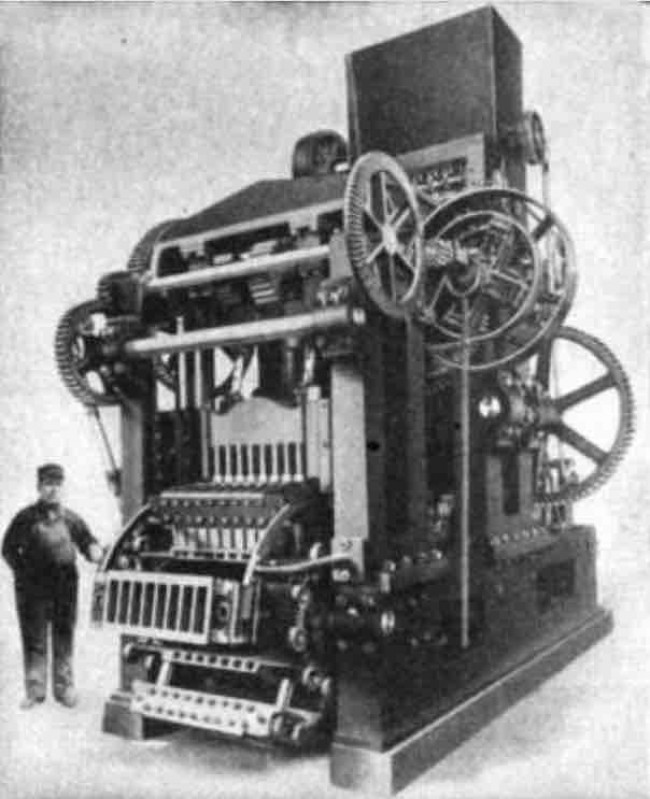
What is the output of this machine?
The answer is here.
Posted By: Paul - Mon Oct 10, 2016 -
Comments (11)
Category: Technology, 1900s
The Goat Lymph Cure
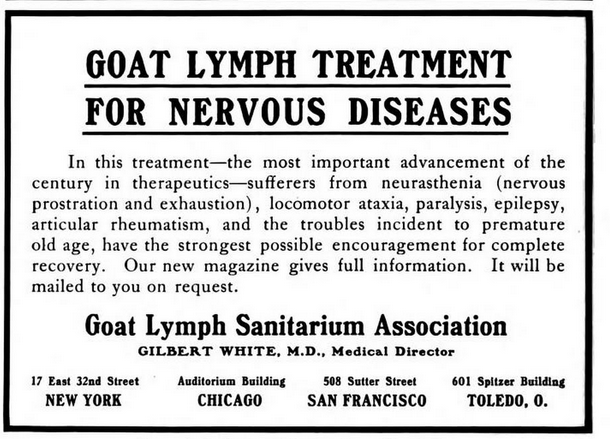
Original ad here.
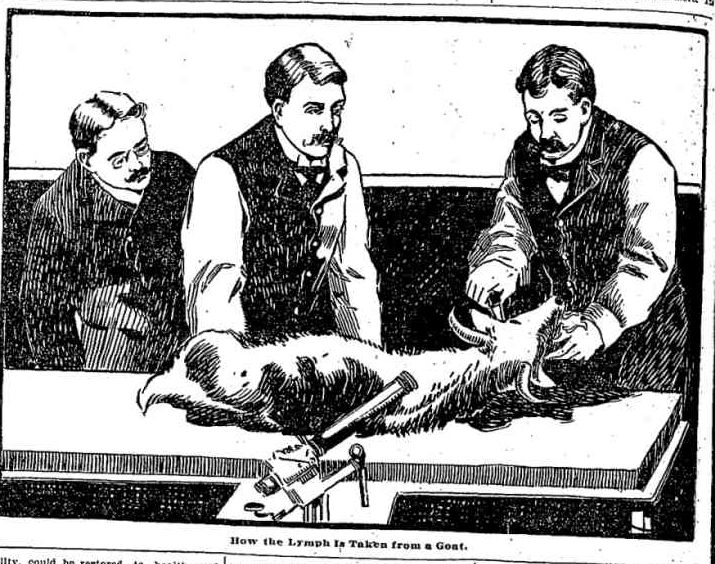
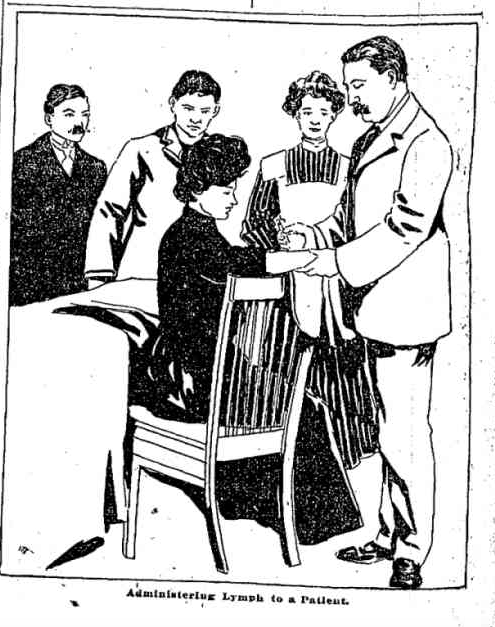
Posted By: Paul - Wed Oct 05, 2016 -
Comments (3)
Category: Animals, Health, Patent Medicines, Nostrums and Snake Oil, Body Fluids, 1900s
Horseback Dinner

Conspicuous Consumption - as it was done in 1903. In order to celebrate the completion of his $200,000 stable, C.K.G. Billings held a "horseback dinner" on March 28, 1903 for 33 of his pals from the Equestrian club. It took 24 workers three days to convert the second-floor banquet hall at Sherry's restaurant in New York into a faux rural barnyard and stable.
The guests ate while seated on their horses. The various courses were served on a table attached to the saddle. There was an individual waiter for each rider, and a groom stood at each horse's head to keep it calm and prevent a sudden start from spilling the food. More details from the NY Post-Dispatch (Mar 29, 1903) :
In the center of the horseshoe formed by the animals was a mound of green, surmounted by a mass of flowers. The grassy sides sloped off into a lawn, which spread to the horse's fore feet.
Beside each horse was a satin upholstered mounting box, from which the diner in the saddle was served. A board fastened athwart the pommel of the saddle served as a table, and that the steed might not curvette or prance or shy, and so spill gravy or salad, a liveried groom stood at each horse's head...
The equestrian guests entered fully into the spirit of the affair and soon the first banquet in the saddle was in full swing. And while the guests ate, so did the horses. While the courses were being served from the mounting blocks to dishes which were secured in holders on the saddle tables the horses munched oats from individual silk-covered mangers.
Twelve courses were served, then the tables were removed from the pommels and the guests lounged over their cigars in the padded saddles. Speeches followed, mostly laudatory of Mr. Billings.
It cost Billings around $1.3 million (in modern money) to host the event.
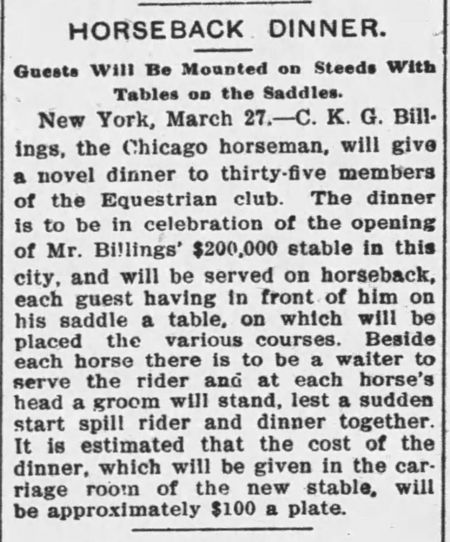
The Town Talk - Mar 27, 1903
Reference: Museum of the City of New York
Posted By: Alex - Sun Sep 25, 2016 -
Comments (2)
Category: Dinners, Banquets, Parties, Tributes, Roasts and Other Celebrations, 1900s
Chinese Fingernail Reading
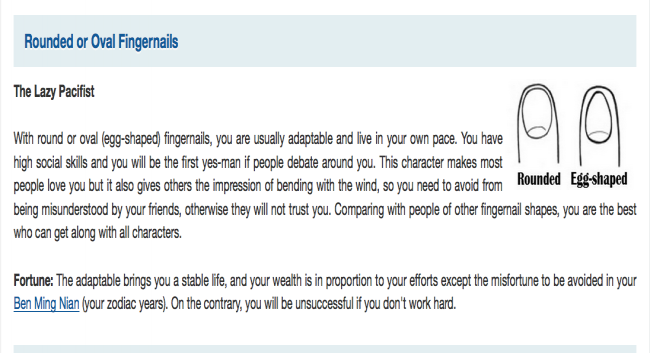
I had been unaware until now that Chinese Palmistry interpreted one's fingernails as well.
A modern guide is here.
But I rather like these interpretations from 1905.
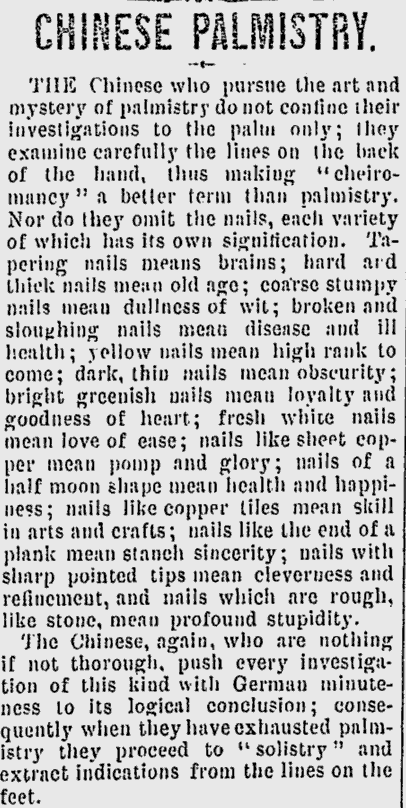
Posted By: Paul - Tue Aug 09, 2016 -
Comments (2)
Category: Body, Superstition, 1900s, Asia
Raise Chickens or Move!
Back in 1906, everyone in Montezuma, Iowa raised chickens. And anyone who didn't was politely encouraged to get out of town."A few have tried to live in Montezuma without engaging in the poultry industry either for pleasure or profit, but they have always found their dislike for chickens growing into a sort of barrier against friendly intercourse with their neighbors and they came to be almost social outcasts."
According to Montezuma's wikipedia page, the town hasn't grown much in the past 100 years. However, the page doesn't say anything about the chicken-raising requirement. Nor does Montezuma's own official website.
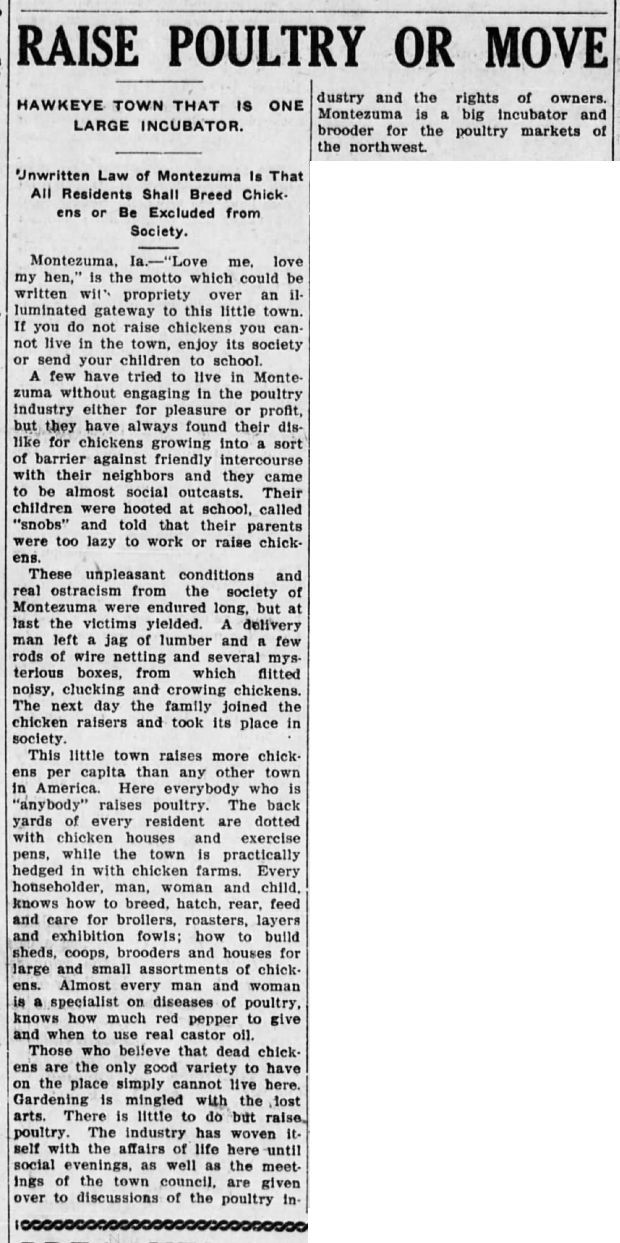
Custer County Republican - Dec 27, 1907
via reddit
Posted By: Alex - Sun Jun 05, 2016 -
Comments (2)
Category: Animals, 1900s
The Billiken
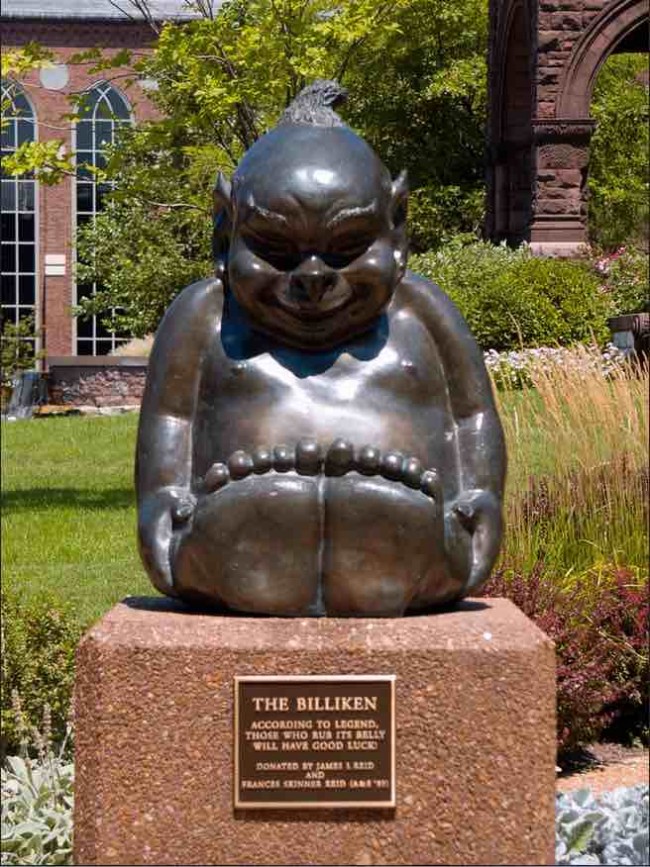
Woman imagines a deity, it become part of the native cultures of Alaska and Japan. That's pretty weird.
Wikipedia entry here.
Posted By: Paul - Mon May 23, 2016 -
Comments (3)
Category: Cult Figures and Artifacts, Religion, Superstition, Foreign Customs, 1900s
X-Ray Stove Polish
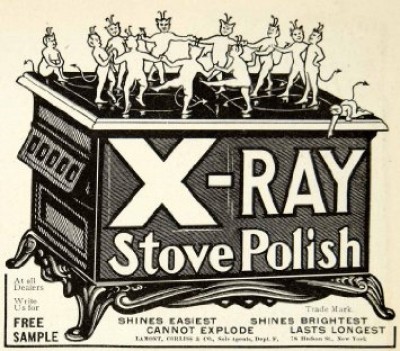
"Cannot explode." Well, that's a relief!
Some more info here.
Posted By: Paul - Thu May 05, 2016 -
Comments (7)
Category: Technology, Corporate Mascots, Icons and Spokesbeings, Appliances, 1900s
Malone the Rat Fighter
Tough way to earn a living.This 1908 news story may have inspired Roald Dahl's short story "The Ratcatcher" (first published in 1953 in Someone Like You). Even if Dahl hadn't seen this exact news piece, he must have heard stories (urban legends) about rat catchers doing this.
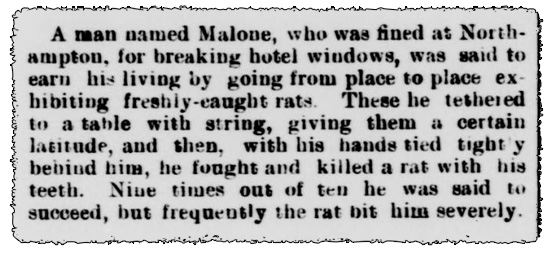
The Royal Gazette - Oct 6, 1908
Posted By: Alex - Sun Apr 03, 2016 -
Comments (9)
Category: Animals, Jobs and Occupations, Pests, Plagues and Infestations, 1900s
The Dogs’ Dinner at Newport
One of the more infamous excesses of the Gilded Age at Newport, Rhode Island, was the "Dogs' Dinner."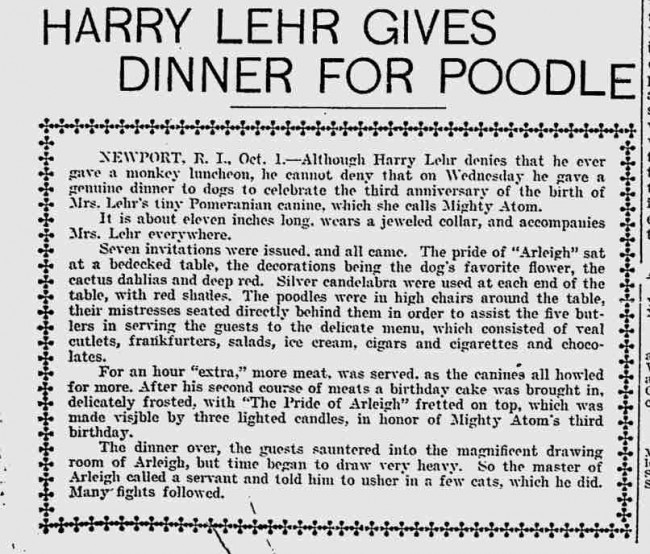
Original article here.
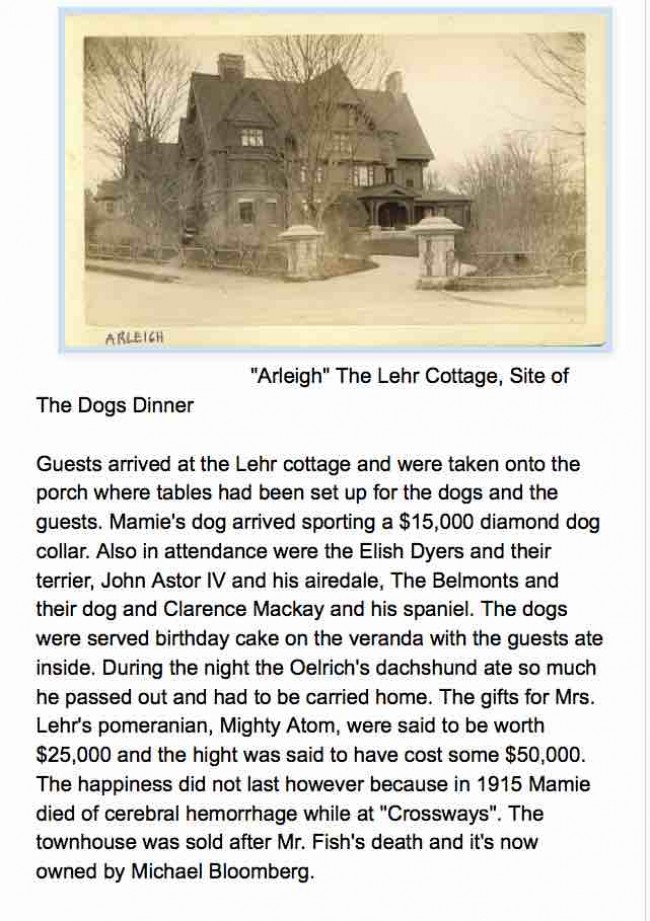
Original page here.
Posted By: Paul - Fri Apr 01, 2016 -
Comments (6)
Category: Excess, Overkill, Hyperbole and Too Much Is Not Enough, Dogs, 1900s

| Who We Are |
|---|
| Alex Boese Alex is the creator and curator of the Museum of Hoaxes. He's also the author of various weird, non-fiction, science-themed books such as Elephants on Acid and Psychedelic Apes. Paul Di Filippo Paul has been paid to put weird ideas into fictional form for over thirty years, in his career as a noted science fiction writer. He has recently begun blogging on many curious topics with three fellow writers at The Inferior 4+1. Contact Us |




